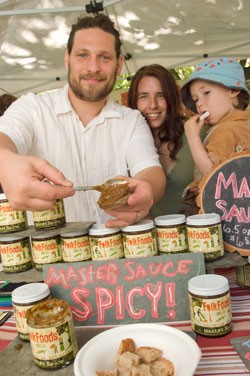
- Andy Duback
- Jason Frishman, Shana Witkin, and Micha Frishman
For six hours, Jason Frishman — cofounder with his wife, Shana Witkin, of specialty-food company FolkFoods — and 10 close friends have been working together to create an almost ludicrous amount of Master Sauce. The flavorful condiment, sold at the couple’s booth at the Burlington Farmers Market, is made from a slew of flavorful ingredients, including carrots, maple syrup, tamarind and fiery habanero peppers.
“All right, everyone,” Frishman says as he begins to set up the jar-filling station, “when you go to the bathroom, don’t touch your genitals once you’ve touched the peppers.”
“Don’t touch anyone else’s genitals, either,” Frishman’s longtime friend and neighbor, Chapin Spencer, says with a smirk.
Putting body parts at risk is a given when one decides to help make FolkFoods’ summer supply of its signature sauce — 650 gallons’ worth. Since it isn’t something a home kitchen can handle, at 8 a.m. on a sunny summer day, Frishman and friends began production in the Vermont Food Venture Center in Fairfax.
A run-down, practically windowless building, the center houses an industrial-sized kitchen that can be rented by small food businesses that would not otherwise have access to one large enough to meet their needs. It has everything, including a Cuisinart the size of a small bathtub.
Peeling paint, grungy rooms and “well-loved” supplies make the 14-year-old building look like it’s on its last legs. The center will move to a new, modernized location in Hardwick next January.
Frishman, usually sunny and full of energy, looks a little glum when someone mentions the center’s relocation. It takes him forever to drive down to Hardwick, he points out, and he still doesn’t know where or how he’ll make his sauce after the move.
Frishman’s positive attitude returns when Eric Van Vlandren, compost manager at Burlington’s Intervale Center and a close friend, bursts into the room hallooing cheers and waving his arms. It’s the kind of reaction Frishman, whose day job is working as a family therapist, seems to elicit on a regular basis.
“I love working with Jason. He has such a carefree personality,” says Brittany Langdon, a FolkFoods employee, housesitter for the couple and friend.
Langdon starts directing traffic and setting up workstations — one for chopping two huge sacks’ worth of white and purple onions, one for measuring spices, one for cleaning.
Watching the scene unfold, it’s easy to see why Frishman attributes his success to his pals. Master Sauce was invented seven years ago when Frishman and Witkin were trying to write a cookbook, not build a company. After three years of urging by his sauce-besotted friends, Frishman finally decided to sell it. “The booth, the bottle’s label, the name — it couldn’t have happened without my friends,” he says.
For example, when crises hit, Frishman has ultimate handyman Sky Lewe on his side.
“What do you mean, the scale is broken?” Frishman asks, hanging on to a jug of cumin. A few minutes later, with the help of a pocketknife and batteries, Lewe has the scale up and running.
Next, helpers dump out gallons of maple syrup and jars of tamarind. To his friends’ chagrin, Frishman’s favorite brand of the pungent pulp comes only in relatively tiny, 16-ounce containers.
As each ingredient is prepared, the crew divides it equally between two huge cooking pots in the back of the room. The pots are set to a low simmer, and everyone gets a chance to stir the concoction with a five-foot-long whisk.
An immersion blender goes into the sauce next, and people begin to cough as fermented habanero pepper fumes from the vats fill the room. “It’s like going to a Cheech & Chong concert, except worse,” Van Vlandren says with a wink.
As the jarring process commences, the laid-back Vermonters form an automotive-style assembly line. Each jar must be placed under a mechanical funnel that spurts exactly six-and-a-half ounces of sauce, then lidded and boxed.
After five hours and numerous habanero burns — which make the skin sting for at least 24 hours — all the sauce is processed.
Given the time commitment, one would think Frishman must be making a great profit when he sells the sauce for $6.50 a jar, but he says he only makes enough to cover costs. He jokes that it’s because he gives away all his sauce to friends. “We don’t have money, and we don’t have time,” he says. “But what we do have is food, and that we can be generous with.”
Frishman holds up the final jar of sauce with a ceremonial flourish. “Done!” he exclaims.
When someone in the group asks what she should do with her allotment of free sauce — which has a subtle, intense heat mixed with a fruity spiciness — Frishman replies that it goes well in curries and on grilled-cheese sandwiches and eggs.
Van Vlandren has a different response. He looks at the questioner blankly, as if she should already know the answer. “Everything,” he says.









Comments
Comments are closed.
From 2014-2020, Seven Days allowed readers to comment on all stories posted on our website. While we've appreciated the suggestions and insights, right now Seven Days is prioritizing our core mission — producing high-quality, responsible local journalism — over moderating online debates between readers.
To criticize, correct or praise our reporting, please send us a letter to the editor or send us a tip. We’ll check it out and report the results.
Online comments may return when we have better tech tools for managing them. Thanks for reading.